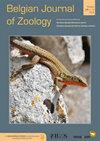Predicting the impact of climate change on the distribution pattern of Agamura persica (Dumeril, 1856) (Squamata: Gekkonidae) in Iran
IF 1.1
4区 生物学
Q2 ZOOLOGY
引用次数: 13
Abstract
Species distribution modeling is an important tool that uses ecological data to aid in biological conservation. In the present study we used prediction methods, including maximum entropy (Maxent), to project the distribution of the Persian Spider gecko and the impact of climate change on its distribution in Iran. The results were consistent between models and indicated that two of the most important variables in determining distribution of Agamura persica are mean temperature of the wettest quarter and temperature seasonality. All of the models used in this study obtained high area-under-the-curve (AUC) values. Because of the nocturnal behavior of the species, these variables can directly affect species’ activity by determining the vegetation type in habitat. Suitable habitats of Agamura persica were in two locations in eastern Iran and a third location in the central plateau. Habitat suitability for this species was increased in the last glacial maximum (LGM), at which time most parts of the Iranian Plateau were suitable (even southwest Iran). However, the suitable habitat area is restricted to the central part of the plateau in the current period. Predictions from four scenarios indicate that future habitat suitability will be patchy and that the central part of the plateau will remain the most important part of the species distribution.预测气候变化对Agamura persica(Dumeril,1856)(Squamata:Gekkonidae)在伊朗分布模式的影响
物种分布建模是利用生态数据辅助生物保护的重要工具。在本研究中,我们使用了包括最大熵(Maxent)在内的预测方法来预测波斯蛛壁虎在伊朗的分布以及气候变化对其分布的影响。模型之间的结果是一致的,并表明在决定桃分布的两个最重要的变量是最潮湿地区的平均温度和温度季节性。本研究中使用的所有模型都获得了高的曲线下面积(AUC)值。由于物种的夜间行为,这些变量可以通过确定栖息地的植被类型来直接影响物种的活动。Agamura persica的适宜栖息地位于伊朗东部的两个地点和中部高原的第三个地点。该物种的栖息地适宜性在上一次冰川盛期(LGM)增加,当时伊朗高原的大部分地区(甚至伊朗西南部)都是适宜的。然而,在当前时期,适宜的栖息地仅限于高原的中部。来自四种情况的预测表明,未来的栖息地适宜性将是不完整的,高原中部仍将是物种分布中最重要的部分。
本文章由计算机程序翻译,如有差异,请以英文原文为准。
求助全文
约1分钟内获得全文
求助全文
来源期刊

Belgian Journal of Zoology
生物-动物学
CiteScore
1.90
自引率
0.00%
发文量
10
审稿时长
>12 weeks
期刊介绍:
The Belgian Journal of Zoology is an open access journal publishing high-quality research papers in English that are original, of broad interest and hypothesis-driven. Manuscripts on all aspects of zoology are considered, including anatomy, behaviour, developmental biology, ecology, evolution, genetics, genomics and physiology. Manuscripts on veterinary topics are outside of the journal’s scope. The Belgian Journal of Zoology also welcomes reviews, especially from complex or poorly understood research fields in zoology. The Belgian Journal of Zoology does no longer publish purely taxonomic papers. Surveys and reports on novel or invasive animal species for Belgium are considered only if sufficient new biological or biogeographic information is included.
 求助内容:
求助内容: 应助结果提醒方式:
应助结果提醒方式:


